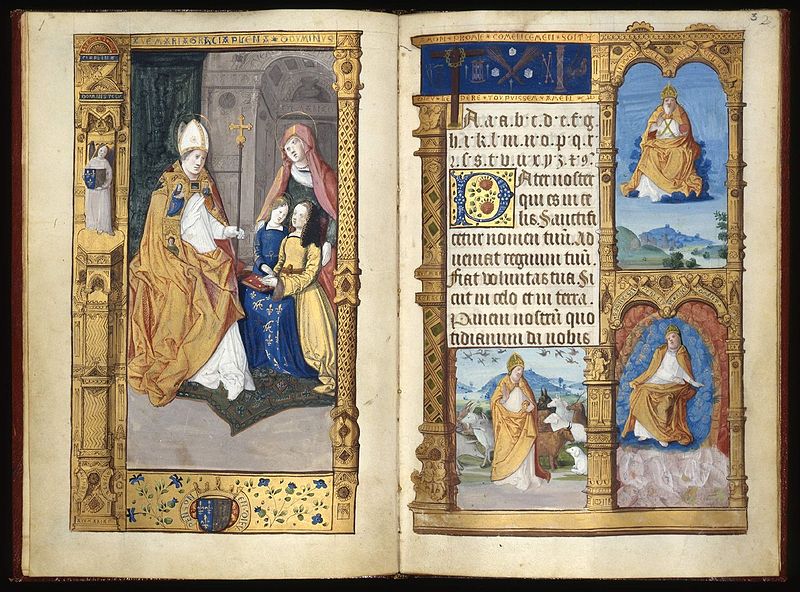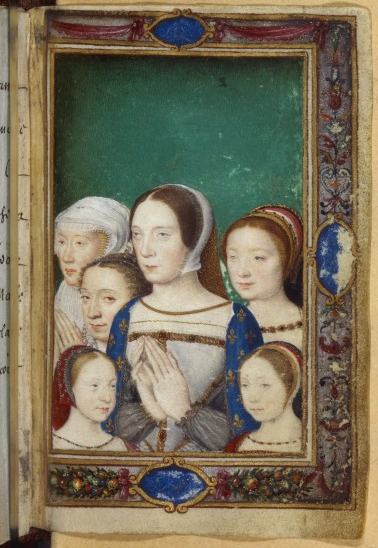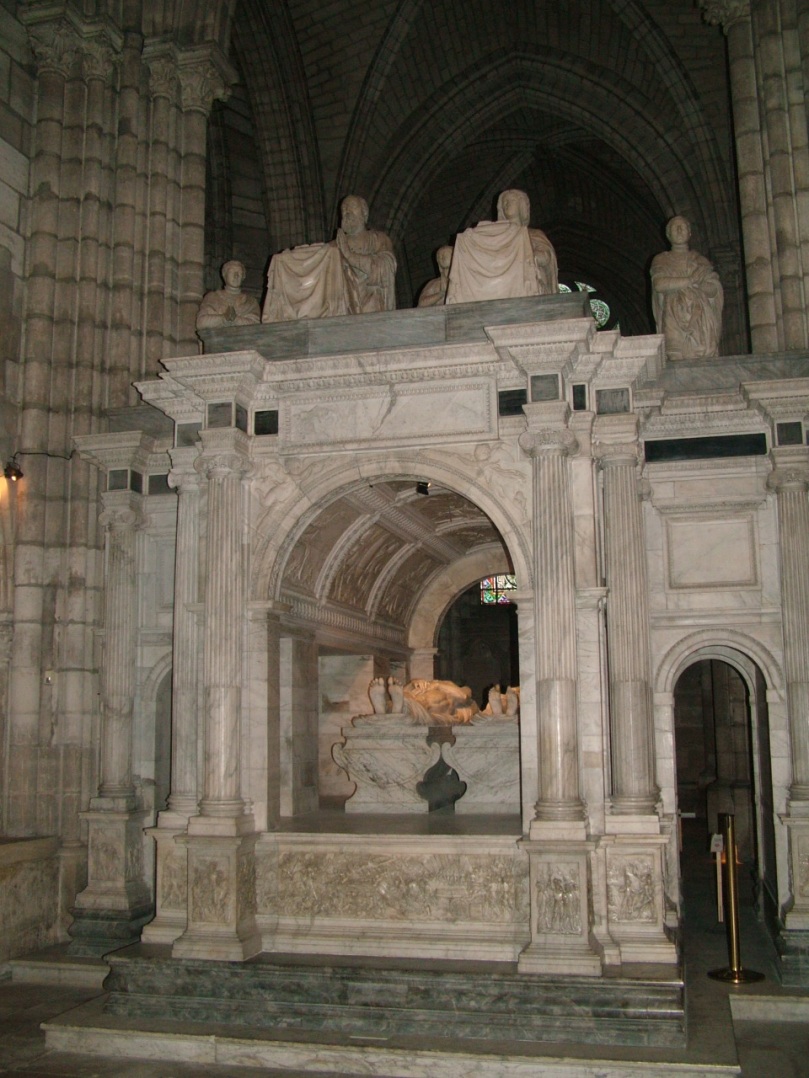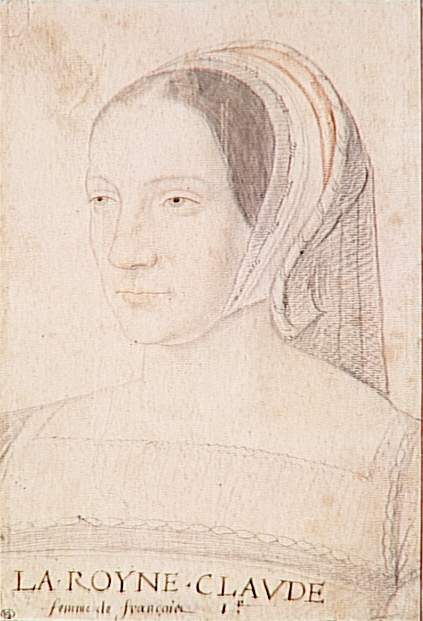“A pearl of a woman…goodness without sin” The Chronicler of Anjou
There is no love story with the marriage of Claude de Valois and King François I of France. Claude’s parents, Anne of Brittany and King Louis XII enjoyed a stable and somewhat loving relationship. But Claude was destined to bring the long-time independent Duchy of Brittany to the French crown and to give birth to male heirs for the throne and daughters to be married off for political and diplomatic reasons.
Claude was born on October 13, 1499 at Romorantin-Lanthenay. She was named after Claudius of Besançon, a seventh century abbot whose name Queen Anne had invoked on pilgrimage in the hopes of the safe delivery of a living child. Claude’s father, King Louis, was at war in Italy when she was born but he returned in November to attend her christening. The marriage contract between Louis and Anne from January 7, 1499 stipulated the Duchy of Brittany would revert to Anne’s heirs exclusively. Because Anne would have no surviving male children, Claude was destined to become Duchess of Brittany in her own right upon the death of her mother.
Claude was raised in the royal Château of Blois under the watchful eye of her governess Madame de Tournon. Her parents doted on her. She was a merry child who easily amused others, especially her father. His eyes would light up in her presence. As she grew older, he would enjoy her company and he would take her hunting with him. Claude revered and loved her mother very much. In November of 1501, when Claude was about two years old, Juana of Castile and Philip of Burgundy visited Blois and Claude was brought in the arms of her governess to greet Juana. Claude took one look at Juana and started screaming at the top of her lungs and had to be taken from the room.
Claude was the only child of Anne and Louis for eleven years when her sister Renée was born. She was never alone during those years. There was always a crowd of little girls who were allowed to play with her. Claude had her own reading primer containing the alphabet and a selection of prayers and Bible stories. Up until Claude was two, she slept in a room between her mother and father’s audience rooms along with her governess. The walls were hung with tapestries depicting pastoral scenes with a sheepfold, little figures and lettering.

During those eleven years Claude was used as a matrimonial pawn by her father. Due to French law, women could not inherit the throne and rule. Because Louis and Anne had no surviving male children, the heir to the French throne was Louis’ relative, François d’Angoulême who was being brought up by his mother Louise of Savoy in Amboise. Louise and François’ guardian Pierre de Gié, strongly advocated for a marriage between Claude and François. Queen Anne was determined to maintain the independence of the Duchy of Brittany and vociferous in promoting a Habsburg marriage with Charles of Ghent, the future Holy Roman Emperor Charles V.
King Louis was caught in the middle of these factions and his policies fluctuated according to the diplomatic wind. In April of 1500, he made a secret pact that the only marriage he would agree to was between Claude and François, nullifying any other arrangement in advance. The agreement was signed and sealed without Queen Anne’s knowledge.
Claude was an unbelievably wealthy and well-endowed match for any husband. Her dowry consisted of Milan, Asti, Naples, the duchies of Burgundy and Brittany and the county of Blois. Her marriage to the Habsburg heir would have been devastating to the security of France. It’s unclear why Louis considered a match with Charles but a betrothal was celebrated in November of 1501 during the visit of Charles’ parents Juana of Castile and Philip of Burgundy to Blois.
In April of 1505, King Louis was gravely ill and the doctor’s feared for his life. At one point he asked for Claude to be brought to him. He wanted to give her is sword and javelin. A wooden staff was substituted for safety’s sake. Thinking he might die, Louis was forced to make a definitive decision regarding the marriage of Claude. In May of 1506 he proclaimed in his will that Claude would marry François d’Angouleme as soon as possible. She was also prohibited from leaving the kingdom of France for any reason, precluding her mother from taking her into exile in Brittany.
Queen Anne was furious and went on a five month long tour of Brittany. This left Louis in a position to consolidate the arrangement. In May he formally announced Claude’s marriage to François as soon as she was old enough. He called an Assembly of Notables which met that same month at Pléssis-lez-Tours. During the course of this meeting, the notables begged Louis to marry Claude to François because he was a Frenchman. Louis graciously agreed.

On January 9, 1514, Claude’s beloved mother died. She was deeply distressed. Even so, conclusion of her marriage came to the forefront and plans quickly went ahead. The wedding took place on May 18, 1514 at Saint-Germain-en-Laye where her father happened to be hunting. The court was in mourning and the marriage was quiet and lacked gaiety. Claude was in tears throughout the entire ceremony. François brought a bed, a bolster and coverlet and Claude contributed silk hangings. François’ mother, who did not attend, noted in her journal they were married at ten o’clock in the morning and they went to bed together that evening. By the time of the marriage, François was a known womanizer and the morning after the wedding, he left to go hunting and seek the company of another woman. He never loved Claude and saw his marriage as his duty to France.
King Louis did not grieve for Queen Anne for long. In October of 1514, he contracted to marry Mary Tudor, the beautiful sister of King Henry VIII of England. Mary arrived early that month in Abbeville, just south of Calais. François rode out to meet her. Louis, who was impatient to see Mary before her official reception, managed to meet her cavalcade by chance on the way back from an afternoon of hawking. After exchanging courtesies, Mary and the King made their separate ways into Abbeville where Claude greeted Mary, escorting her to her lodgings. Claude was Mary’s companion for the duration of the festivities. After the wedding ceremony on October 9, Claude escorted Mary to the marital bedchamber.
Three months later, on January 1, 1515, Louis died. Claude’s husband was now King François I. The chroniclers are universal in their praise of Claude as the epitome of the ideal queen. She is described by the Austrian ambassador as being retiring with a pale complexion, thin, a little sickly, slightly hunchbacked and somewhat unattractive. He goes on to say she was very small with a strange corpulence and her grace in speaking compensated greatly for her lack of beauty. In “The Travel Journal of Antonio De Beatis”, he says the Queen is young and though small in stature, plain and badly lame in both hips, she is very cultivated, generous and pious.
She shared an interest with her husband in building and was involved in the construction of Renaissance architectural monuments. The “François I wing” of the Chateau of Blois was constructed under her supervision. Like her mother, she developed the use of illuminated manuscripts in advancing her own image. It was hard for her to shine. Her husband was brilliant, her mother-in-law was domineering and her sister-in-law Marguerite was unconventional. Her husband didn’t hesitate to promote and showcase his official mistresses.
Claude was retiring in nature, amiable and unobtrusive, taking no role in the politics of her husband’s reign. She never tried to factionalize the court and endured her situation with grace. She admirably fulfilled her duty in producing children. She had seven children in eight years. Five survived into adulthood. François was born in 1518. The future King Henri II was born in 1519 and Charles was born in 1522. Madeleine was born in 1520 and would fall in love with and marry King James V of Scots. Marguerite, born in 1523 married Emmanuel-Philibert of Savoy. Two other daughters died young: Louise at the age of two and Charlotte at the age of seven.

Claude made very few public appearances during her reign. Her many pregnancies caused her health to suffer making it difficult to travel and fulfill ceremonial duties. She went on pilgrimage to southeastern France in 1515 to pray for having a son. She also visited Brittany in 1518 where she was received with enthusiasm as the Duchess of Brittany as opposed to being Queen of France. Because of her many pregnancies and the difficulties they caused for her health, she wasn’t consecrated as Queen until 1517. Claude did attend the Field of Cloth of Gold meeting in June of 1520 along with Henry VIII’s queen, Katherine of Aragon. But both ladies were self-effacing. Claude’s mother-in-law, sister-in-law and her husband’s official mistresses stepped in to fulfill her official roles.
With each pregnancy, Claude became more obese and incapacitated and even more removed from public life. Her limp, caused by her scoliosis and deformed hips, became more pronounced. She became increasingly more private, withdrawing to Blois where she occupied herself with her ladies-in-waiting (including Anne Boleyn), living in piety and joining the Third Order of Franciscans. Her last years were isolated and melancholy as she became more immobile. The birth of her last daughter Marguerite in 1523 sapped all of her strength. It became increasingly clear she would not live long. She may also have suffered from the effects of syphilis given to her by her husband who was likely infected at a young age.

She died at Blois on July 20, 1524. François made sure she had an impressive funeral and she was buried in the Basilica of Saint Denis. François was preparing to go to war and did not return for the ceremony. However, in a letter to his mother he noted he never would have thought that the tie of marriage joined by God would be so difficult to break. Even his good friend Robert Fleuranges III de La Marck, marshal of France, noted Francois’ grief. He would not take another wife until 1530 when he married Eleanor of Austria, the sister of the Hapsburg Emperor Charles V.
Further reading: “The Valois: Kings of France 1328-1589” by Robert Knecht, “Queens and Mistresses of Renaissance France” by Kathleen Wellman, “Queen’s Mate: Three women of power in France on the eve of the Renaissance” by Pauline Matarasso

[…] born in the royal château of Amboise in France in 1518, was the son of King Francois I and Queen Claude, Duchess of Brittany. Francis received the required education for a young man of his status. At the age of six, his […]
LikeLike
[…] cathedral. James V, King of Scots married Madeleine de Valois, the daughter of King Francis I and Queen Claude. It was a true love match. On April 24, 1558, Mary Queen of Scots married the Dauphin […]
LikeLike
Hello Susan -big fan here – something has been puzzling me. Francois I was next in line, plus Lous XII named him as his successor, so he didnt need to marry Claude to be king. From your research it looks as if the powers that be wanted him simply because he was French. As king he could have married anyone so why did he agree to marry someone who held no attraction for him? Thank you- Pamela from Amboise
LikeLiked by 1 person
Thanks for being a fan! As it states in the first paragraph, Claude was destined to bring the long-time independent Duchy of Brittany to the French crown. Claude’s mother, Anne of Brittany, fought long and hard to keep Brittany separate from France but Francois coveted the rich province. Also, Francois wasn’t king when he married Claude, so he really didn’t have a choice at that point. There was a faction at court, headed by Queen Anne, who wanted her daughter to marry someone from the Hapsburg Empire to keep Brittany separate. See the story of Claude and Francois’ eldest son for more on the annexation of Brittany: https://thefreelancehistorywriter.com/2016/06/17/francis-de-valois-dauphin-of-france-and-duke-of-brittany/
LikeLike
Bonjour Susan (from Amboise). Marie of Guise visited her daughter in France to celebrate her engagement to the Dauphin but not her wedding? Is that right? If so, why not? Have just ordered *Queen’s Play* by Dorothy Dunnett. It’s said to be about Marie’s visit to France. I had never heard of her. Do you know her books? If so, recommend them? all good wishes Pamela http://www.pamela-shields.co.uk
On Thu, 29 Jul 2021 at 15:48, The Freelance History Writer wrote:
> Susan Abernethy commented: “Thanks for being a fan! As it states in the > first paragraph, Claude was destined to bring the long-time independent > Duchy of Brittany to the French crown. Claude’s mother, Anne of Brittany, > fought long and hard to keep Brittany separate from France but Fr” >
LikeLike
Reblogged this on Anniegoose's Blog and commented:
another great post 🙂
LikeLike
Great info and good read. Keep more coming
LikeLike
That poor woman. Your descriptions are wonderful; Made me feel the physical pain she must have endured. Thanks so much, Susan.
LikeLiked by 1 person
You’re welcome Kalli. That is the effect I’m going for.
LikeLike
A spicy note: Francois fell in passionate love with the beautiful Mary Tudor and it was his mother who had to point out to him that a liaison with the new Queen of France could result in a new heir to the throne. That cooled him off.
LikeLiked by 1 person
HaHa Iva! Francois would have been in a lot of trouble without his mother. She was a very intelligent woman.
LikeLike
Oh, poor woman! What a devoted mother and wife, and with so much to bear. Her story deserves to be more widely known. Very interesting, Susan.
LikeLiked by 1 person
A touching story
LikeLiked by 1 person
you always write the most interesting blogs – thank you for sharing.
LikeLiked by 1 person
You’re very welcome Anne!
LikeLike